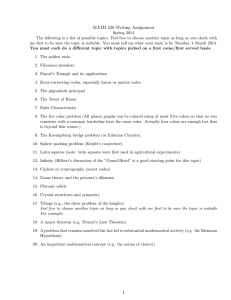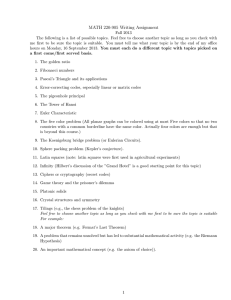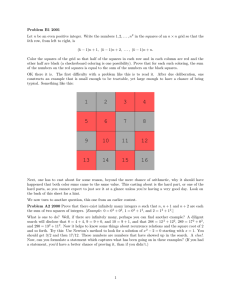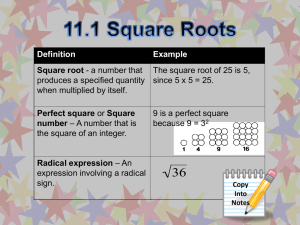INTEGERS 10 (2010), 559-563 #A46 FINDING ALMOST SQUARES V Tsz Ho Chan
advertisement
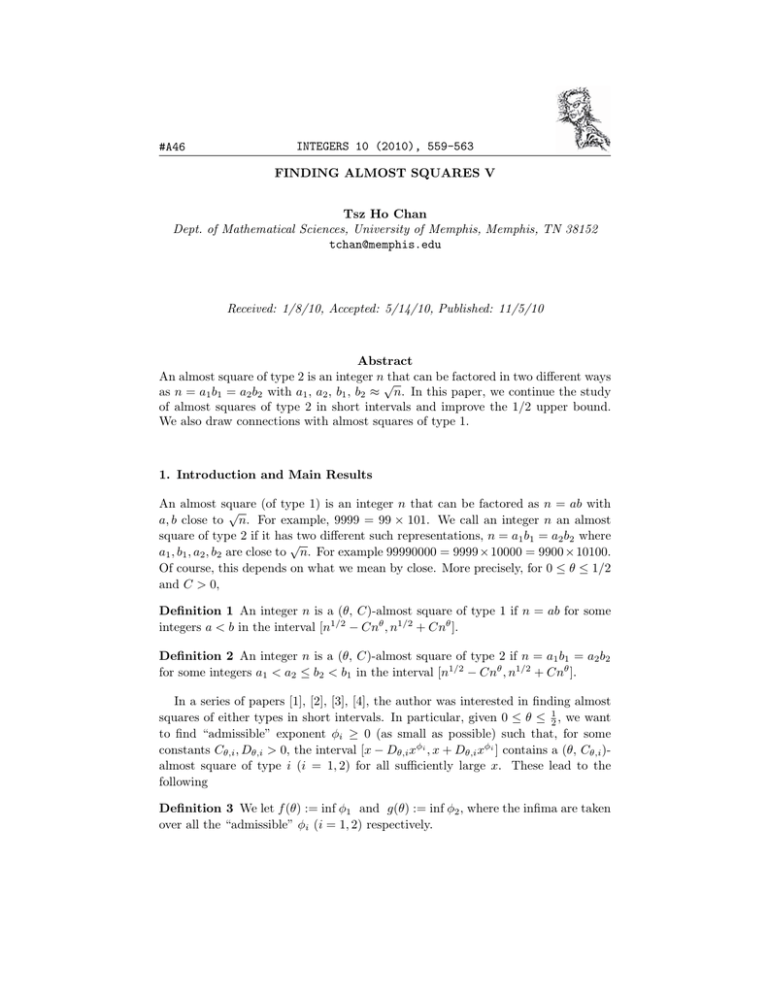
#A46
INTEGERS 10 (2010), 559-563
FINDING ALMOST SQUARES V
Tsz Ho Chan
Dept. of Mathematical Sciences, University of Memphis, Memphis, TN 38152
tchan@memphis.edu
Received: 1/8/10, Accepted: 5/14/10, Published: 11/5/10
Abstract
An almost square of type 2 is an integer n√
that can be factored in two different ways
as n = a1 b1 = a2 b2 with a1 , a2 , b1 , b2 ≈ n. In this paper, we continue the study
of almost squares of type 2 in short intervals and improve the 1/2 upper bound.
We also draw connections with almost squares of type 1.
1. Introduction and Main Results
An almost square (of type 1) is an integer n that can be factored as n = ab with
√
a, b close to n. For example, 9999 = 99 × 101. We call an integer n an almost
square of type 2 if it has two different such representations, n = a1 b1 = a2 b2 where
√
a1 , b1 , a2 , b2 are close to n. For example 99990000 = 9999 × 10000 = 9900 × 10100.
Of course, this depends on what we mean by close. More precisely, for 0 ≤ θ ≤ 1/2
and C > 0,
Definition 1 An integer n is a (θ, C)-almost square of type 1 if n = ab for some
integers a < b in the interval [n1/2 − Cnθ , n1/2 + Cnθ ].
Definition 2 An integer n is a (θ, C)-almost square of type 2 if n = a1 b1 = a2 b2
for some integers a1 < a2 ≤ b2 < b1 in the interval [n1/2 − Cnθ , n1/2 + Cnθ ].
In a series of papers [1], [2], [3], [4], the author was interested in finding almost
squares of either types in short intervals. In particular, given 0 ≤ θ ≤ 12 , we want
to find “admissible” exponent φi ≥ 0 (as small as possible) such that, for some
constants Cθ,i , Dθ,i > 0, the interval [x − Dθ,i xφi , x + Dθ,i xφi ] contains a (θ, Cθ,i )almost square of type i (i = 1, 2) for all sufficiently large x. These lead to the
following
Definition 3 We let f (θ) := inf φ1 and g(θ) := inf φ2 , where the infima are taken
over all the “admissible” φi (i = 1, 2) respectively.
560
INTEGERS: 10 (2010)
Clearly f and g are non-increasing functions of θ. It was conjectured (and partially verified) that
Conjecture 4 For 0 ≤ θ ≤ 12 ,
f (θ) =
!
1
2,
1
2 −
if 0 ≤ θ < 14 ,
if 14 ≤ θ ≤ 12 ;
θ,
and
g(θ) =
!
does not exist,
1 − 2θ,
if 0 ≤ θ < 14 ,
if 14 ≤ θ ≤ 12 .
In [3], it was proved that
Theorem 5 For
1
4
≤ θ ≤ 12 ,
g(θ) ≤
5
8,
if
1
4
17
32 ,
if
5
16
1
2,
if
743
2306
≤θ≤
≤θ≤
The purpose of this paper is to improve the
range of θ, namely
Theorem 6 For
1
3
5
16 ,
743
2306 ,
< θ ≤ 12 .
1
2
≤ θ ≤ 12 , we have g(θ) ≤ 1 −
upper bound for g(θ) in certain
3θ
2 .
Combining the above two theorems, we have the following picture:
g(θ)
1
5
8 17
1 32
2
0
1
4
!! !!!
!!
!!
!!
!!
!!
!!
5 743
16 2306
1
2
θ
561
INTEGERS: 10 (2010)
The thin downward sloping line is the conjectural lower bound 1 − 2θ while the
thick line segments above are the upper bounds from Theorems 5 and 6.
Furthermore, there are some connections between almost squares of type 1 and
almost squares of type 2.
Theorem 7 If Conjecture 4 is true for f (θ) when
g(θ) ≤
for
1
3
1
4
≤ θ ≤ 12 , then
3
− 3θ
2
≤ θ ≤ 12 .
Notation. Both f (x) = O(g(x)) and f (x) ' g(x) mean that |f (x)| ≤ Cg(x) for
some constant C > 0.
2. Unconditional Result: Theorem 6
Proof. We shall use the fact: for any real number x ≥ 1, there exists a perfect
√
square a2 such that a2 ≤ x < (a + 1)2 . Hence |x − a2 | ' x.
Given x ≥ 1 sufficiently large. The almost square of type 2 close to x we have in
mind has the form
n = (G2 − 1)(H 2 − h2 ) = a1 b1 = a2 b2 ,
where {a1 , b1 } = {(G − 1)(H − h), (G + 1)(H + h)} and {a2 , b2 } = {(G − 1)(H +
h), (G + 1)(H − h)}.
Let 0 < λ < 14 . We choose G = [x1/4−λ ].
First, we approximate
x
G2 −1
x
G2 −1
' H. One can check that
'(
GH = G
&
by H 2 where H = [ G2x−1 + 1]. Then 0 < H 2 −
)
*
* 1 ++
x
1/2
+
1
=
x
1
+
O
+ O(G) = x1/2 + O(x2λ ) + O(x1/4−λ ).
G2 − 1
G2
Next, we approximate H 2 − G2x−1 by h2 for some 0 < h ' H 1/2 ' x1/8+λ/2 . We
can get within a distance H 2 − G2x−1 − h2 ' H 1/2 ' x1/8+λ/2 . Therefore
,
,
|x − (G2 − 1)(H 2 − h2 )| ≤ ,
,
x
2
2 , 2
−
(H
−
h
)
,G ' G2 x1/8+λ/2 ' x5/8−3λ/2 .
G2 − 1
562
INTEGERS: 10 (2010)
The number n = (G2 − 1)(H 2 − h2 ) = (G − 1)(G + 1)(H − h)(H + h). Notice that
(G − 1)(H − h) = GH − H − Gh + h
= x1/2 + O(x2λ ) + O(x1/4−λ )
+ O(x1/4+λ ) + O(x3/8−λ/2 ) + O(x1/8+λ/2 )
= x1/2 + O(x1/4+λ ) + O(x3/8−λ/2 ).
One can check that the same asymptotic holds for (G − 1)(H + h), (G + 1)(H − h)
1
and (G + 1)(H + h). When λ ≥ 12
, the first error term dominates. Thus, we just
1
have found a ( 4 +λ, C)-almost square of type 2 within a distance O(x5/8−3λ/2 ) from
x for some C > 0.
1
Set θ = 14 + λ. The condition 12
≤ λ < 14 becomes 13 ≤ θ < 12 . Meanwhile
5
3λ
3θ
1
1
8 − 2 = 1 − 2 . Therefore, for any 3 ≤ θ < 2 , there exists a (θ, C)-almost square
1
1
of type 2 within a distance O(x1−3θ/2 ) from x. So g(θ) ≤ 1 − 3θ
2 when 3 ≤ θ < 2 .
1
1
When λ = 4 (i.e. θ = 2 ), one simply uses G = 2 and the above argument works in
the same way to give g( 12 ) ≤ 14 .
!
3. Connection to Almost Squares of Type 1: Theorem 7
Proof. In the previous section, we used an elementary method to approximate G2x−1
by (H − h)(H + h), a ( 14 , C)-almost square of type 1, since h ' H 1/2 ' ( G2x−1 )1/4 .
So one should expect to do better using (φ, C)-almost square of type 1 for some
1
1
4 ≤ φ ≤ 2.
&
Again we choose G = [x1/4−λ ] and let H = G2x−1 . By Conjecture 4 on f (θ),
we can find a (φ, C)-almost square of type 1, say ab, such that H − CH 2φ ≤ a <
b ≤ H + CH 2φ and
,
,
,
,
* x +1/2−φ+$
x
,
−
ab
'
' x1/4−φ/2+λ−2λφ+$
,
G2 − 1
G2 − 1
for x sufficiently large. Hence
|x − (G − 1)(G + 1)ab| ' x3/4−λ−φ/2−2λφ+$ .
(1)
Similar to the previous section, one has
(G − 1)a = (G − 1)(H + O(H 2φ )) = GH − H + O(GH 2φ )
= x1/2 + O(x1/4+λ ) + O(x1/4−λ+φ/2+2λφ ).
563
INTEGERS: 10 (2010)
The same is true for (G − 1)b, (G + 1)a and (G + 1)b. One can check that
φ
φ
1
4 − λ + 2 + 2λφ if and only if λ ≥ 4−4φ .
Let θ =
1
4
+λ and λ =
φ
4−4φ .
1
4
+λ ≥
Then the exponent in (1) satisfies 34 −λ− φ2 −2λφ =
φ
1 − θ(1 + 2φ). Therefore, for any 14 + 4−4φ
≤ θ ≤ 12 , there exists a (θ, C " )-almost
1−θ(1+2φ)+$
square of type 2 within a distance of O(x
) from x for some C " > 0.
φ
Given 13 ≤ θ ≤ 12 , the bigger the φ, the better the above result. Since 4−4φ
is an
φ
increasing function of φ, the biggest φ we can use is when 14 + 4−4φ
= θ. This gives
1
1
1
"
φ = 1 − 4θ ≤ 2 as θ ≤ 2 . Using this value of φ, we have a (θ, C )-almost square of
type 2 within a distance of O(x3/2−3θ+$ ) from x. This proves Theorem 7 as $ can
be arbitrarily small.
!
Remark. The exponent 32 − 3θ → 0 as θ → 12 . However 32 − 3θ is always greater
than the conjectural value 1 − 2θ for g(θ) which is no surprise as part of the almost
square has the special form G2 − 1. It would be interesting to see how one could
incorporate the extra degree of freedom, namely G2 − g 2 for some g, for further
improvements.
References
[1] T.H. Chan, Finding almost squares, Acta Arith. 121 (2006), no. 3, 221–232.
[2] T.H. Chan, Finding almost squares II, Integers 5 (2005), no. 1, A23, 4 pp. (electronic).
[3] T.H. Chan, Finding almost squares III, in Combinatorial Number Theory, 7–16, Walter de
Gruyter, Berlin, 2009.
[4] T.H. Chan, Finding almost squares IV, Arch. Math. (Basel) 92 (2009), no. 4, 303–313.



